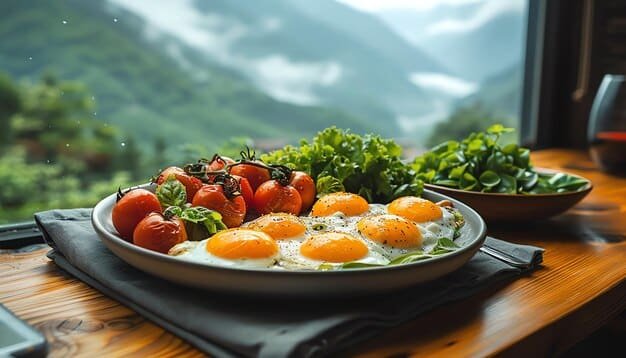Eggs are a versatile and affordable protein that can be cooked in a variety of ways. They are a staple in many breakfast dishes and can also be used to create delicious meals throughout the day. Let’s explore the different styles of cooking eggs and how they can enhance your meals.
Key Takeaways:
- There are numerous egg cooking styles that can add flavor and variety to your meals.
- Fried eggs offer different textures and flavors depending on how they are cooked.
- Scrambled eggs can be made soft and fluffy or cooked until firm.
- Boiled eggs are versatile and can be used in salads or enjoyed as a snack.
- Poached eggs are a delicacy, often used in dishes like eggs benedict.
Also Read : Discover Fascinating Forest Animals In Nature
Egg Cooking Styles
Fried eggs are a classic and popular way to cook eggs. Whether you prefer a runny yolk or a fully cooked yolk, there are different variations of fried eggs to suit your preference.
Sunny Side Up: In this style, the egg is fried on one side without flipping it, resulting in a runny yolk. The sunny side up eggs are visually appealing, with the yolk shining like the sun on the surface of the egg white. They are perfect for breakfast or brunch, especially when served with toast or bacon.
Also Read : Public Opinion Obituaries – Celebrate Lives Lived
Over Easy: Over easy eggs are cooked on both sides but still have a runny yolk. The egg is flipped during cooking and cooked just enough to create a film on the top of the yolk. This style is ideal for those who enjoy a slightly more cooked yolk while still enjoying the creaminess and richness. Over easy eggs are often used in breakfast sandwiches or served with a side of crispy hash browns.
Over Medium: Over medium eggs are cooked a bit longer than over easy eggs, resulting in a slightly firmer yolk while still maintaining some creaminess. The yolk is still semi-liquid, making it a great choice for dipping toast or spreading over a breakfast burrito. The whites of over medium eggs are fully cooked.
Over Hard: For those who prefer a fully cooked yolk, over hard eggs are the way to go. In this style, the yolk is completely cooked through, resulting in a firm texture. Over hard eggs are versatile and can be used in a variety of dishes, from breakfast sandwiches to fried rice.
Also Read : Compassionate Care At My Pets Animal Hospital
Experiment with different variations of fried eggs to find your favorite style. Enjoy them for breakfast, lunch, or dinner, and savor the deliciousness of a perfectly cooked fried egg.
Stay tuned for the next section where we’ll explore another popular way to cook eggs – scrambled eggs!
Scrambled Eggs

Scrambled eggs are a beloved and versatile way to enjoy eggs. Whether you prefer them for breakfast, brunch, or even dinner, scrambled eggs are always a satisfying choice. The key to making delicious scrambled eggs lies in finding the perfect balance of doneness and texture.
When it comes to scrambled eggs, there are different levels of doneness. Hard scrambled eggs are cooked all the way through, resulting in firm and fully cooked eggs. On the other hand, soft scrambled eggs are light, fluffy, and slightly runny.
Also Read : Top Picks For Best Chinese Food Boston | Local Guide
To achieve soft scrambled eggs:
- Crack the eggs into a bowl and whisk them gently until the whites and yolks are well combined.
- Heat a non-stick pan over medium heat and add a small amount of butter or oil.
- Pour the whisked eggs into the pan and immediately start stirring them with a spatula.
- Continue to stir the eggs constantly, incorporating the cooked portions from the edges into the runnier portions in the center.
- Cook until the eggs are no longer runny but still look wet. The residual heat will finish cooking them to perfection.
- Season with salt, pepper, or any other desired herbs and spices.
“Soft scrambled eggs should be light, slightly runny, and oh-so-creamy. They melt in your mouth and make for a delightful breakfast treat.”
Also Read : Earn Your Special Education Certification Online
If you prefer hard scrambled eggs, simply continue cooking them for a longer period of time until they are fully set throughout. Hard scrambled eggs offer a more substantial texture and are ideal for those who like their eggs well-cooked.
No matter the level of doneness you prefer, scrambled eggs are a comforting and customizable dish. You can add a variety of ingredients like cheese, vegetables, or even crumbled bacon to elevate the taste and texture. Serve them with a side of crispy toast or as a filling for breakfast burritos.
Boiled Eggs

Boiled eggs are a versatile option that can be used in various dishes. Whether you prefer them hard-boiled or soft-boiled, there are endless possibilities for incorporating boiled eggs into your meals.
Hard-boiled eggs: To make hard-boiled eggs, simply place them in a pot of boiling water and cook until both the whites and yolks are completely set. You can enjoy hard-boiled eggs sliced on top of a salad, stuffed into sandwiches, or transformed into a creamy egg salad.
Soft-boiled eggs: Soft-boiled eggs have a runny yolk and are a delicious treat. To achieve the perfect soft-boiled egg, gently place the eggs in boiling water and let them cook for a few minutes until the whites are set and the yolks are still slightly liquid. Once cooked, you can tap the top of the egg and scoop out the velvety yolk, which pairs beautifully with toast or as a dipping sauce for soldiers.
| Preparation | Hard-Boiled Eggs | Soft-Boiled Eggs |
|---|---|---|
| Texture | Firm and fully cooked yolks | Runny yolks |
| Shelf Life | Lasts up to one week in the refrigerator | Best enjoyed immediately |
| Versatility | Perfect for salads, sandwiches, or as a standalone snack | Great for dipping, spreading on toast, or serving with other breakfast components |
Boiled eggs are not only delicious but also packed with protein and essential nutrients, making them a healthy addition to any meal. So whether you’re looking for a quick and easy snack or a versatile ingredient for your recipes, boiled eggs are a fantastic choice.
Continue reading to discover more exciting cooking styles for eggs in the upcoming sections.
Poached Eggs
Poached eggs are a delicacy that brings a unique cooking technique to the table. This method involves gently boiling the eggs outside of their shells, resulting in perfectly cooked whites and warm, runny yolks. The result is a luxurious and delicate texture that is highly desirable to egg enthusiasts.
One popular dish that showcases poached eggs is eggs benedict. Often served for brunch or a special breakfast, eggs benedict is a heavenly combination of poached eggs, an English muffin, ham, and hollandaise sauce. The silky yolk blends with the creamy sauce, while a hint of saltiness from the ham complements the dish perfectly.
When poaching eggs, it’s important to use the right technique to achieve the desired result. Some methods involve creating a whirlpool in the water to help the egg whites wrap around the yolk, while others utilize a strainer to remove any excess liquid. Either way, mastering the art of poaching eggs takes practice and patience.
Tips for Perfect Poached Eggs:
- Use fresh eggs for the best results.
- Add a splash of vinegar to the water to help coagulate the egg whites.
- Crack the eggs into separate bowls before gently sliding them into the simmering water.
- Cook the eggs for 3-5 minutes, depending on your desired level of doneness.
- Remove the eggs from the water using a slotted spoon and place them on a paper towel to absorb any excess moisture.
Poached eggs bring a touch of elegance to any meal. Their smooth, velvety texture pairs perfectly with a variety of savory ingredients, making them a versatile addition to your culinary repertoire.
So, whether you’re enjoying a classic eggs benedict for brunch or adding a poached egg to a salad or grain bowl for a protein boost, the delicate and rich flavor of poached eggs is sure to elevate your dish to new heights.
Next, let’s explore another popular cooking style: baked eggs. Get ready for a delicious and satisfying experience!
Baked Eggs

Baked eggs, also known as shirred eggs, are a delicious and versatile breakfast or brunch dish. These eggs are cracked and cooked in a dish, often combined with other ingredients like cream, tomatoes, cheese, and herbs. The dish is then baked until the egg whites are fully cooked and the yolks are still soft and runny.
Baked eggs are incredibly flavorful as they blend perfectly with the other ingredients. The creamy texture of the eggs pairs well with the richness of the cheeses and the freshness of the herbs. The dish can also be customized to include your favorite ingredients, such as spinach, mushrooms, or crispy bacon.
One of the advantages of baked eggs is that they are easy to prepare. Simply crack the eggs into a greased baking dish, add the desired ingredients and seasonings, and bake until the eggs are cooked to your liking. The dish can be served hot and bubbly straight from the oven, making it an impressive choice for entertaining guests.
Not only are baked eggs delicious, but they are also a nutritious breakfast option. Eggs are packed with protein and vital nutrients, making them a satisfying and energizing meal to start the day. By adding vegetables and lean proteins, you can further enhance the nutritional value of the dish.
Whether you enjoy them on their own or with a side of crispy toast, baked eggs are a flavorful and satisfying way to elevate your breakfast or brunch. The combination of savory flavors, creamy textures, and runny yolks makes baked eggs a true crowd-pleaser. Try experimenting with different ingredient combinations to create your own signature dish.
Benefits of Baked Eggs:
- Rich and creamy textures from the combination of eggs and cheeses
- Customizable with your favorite ingredients
- Nutritious and protein-packed
- Easy to prepare and perfect for entertaining
Recipe: Baked Eggs with Spinach and Feta
Here’s a simple recipe to try:
| Ingredients | Instructions |
|---|---|
| 4 eggs | 1. Preheat the oven to 375°F (190°C). |
| 1 cup spinach, chopped | 2. In a greased baking dish, evenly spread the chopped spinach. |
| 1/4 cup crumbled feta cheese | 3. Sprinkle the crumbled feta cheese over the spinach. |
| Salt and pepper to taste | 4. Season with salt and pepper. |
| 1 tablespoon fresh dill, chopped | 5. Sprinkle the fresh dill over the dish. |
| 6. Carefully crack the eggs over the ingredients, ensuring they are evenly distributed. | |
| 7. Bake in the preheated oven for 12-15 minutes, or until the whites are set and the yolks are still soft. | |
| 8. Remove from the oven and let cool for a few minutes before serving. |
Enjoy this delightful baked eggs recipe as a satisfying breakfast or a flavorful brunch option. You can also customize the ingredients to create your own unique variation of baked eggs.
Omelettes
Omelettes are a popular choice for breakfast or any meal of the day. They are made by whisking eggs and cooking them in a pan with various fillings such as cheese, vegetables, and meats. Omelettes can be folded or left open-faced and can be customized with different fillings to suit your taste.
When it comes to omelettes, the possibilities are endless. You can experiment with different combinations of fillings to create a dish that satisfies your cravings. Whether you prefer a classic omelette with cheese and ham or a veggie-packed omelette with mushrooms, spinach, and bell peppers, there is a flavor profile to please every palate.
Here are some popular omelette fillings:
- Cheese: Cheddar, Swiss, feta, or goat cheese.
- Vegetables: Bell peppers, onions, tomatoes, mushrooms, spinach, or broccoli.
- Meats: Ham, bacon, sausage, or leftover shredded chicken.
The key to a perfect omelette is to cook it gently over medium heat, allowing the eggs to set without browning. This ensures a creamy and tender texture. Once the eggs are almost set, you can sprinkle your chosen fillings on one side of the omelette. Using a spatula, fold the other side over the fillings, creating a half-moon shape.
Here’s a simple recipe for a classic cheese omelette:
Classic Cheese Omelette:
- 3 large eggs
- 1/4 cup shredded cheese (cheddar, Swiss, or your favorite)
- Salt and pepper to taste
- 1 tablespoon butter
1. In a bowl, whisk the eggs until well beaten. Season with salt and pepper.
2. Heat a non-stick skillet over medium heat and melt the butter.
3. Pour the beaten eggs into the skillet and let them cook undisturbed for a minute or until the edges start to set.
4. Sprinkle the shredded cheese on one side of the omelette.
5. Using a spatula, fold the other side of the omelette over the cheese.
6. Cook for another minute or until the cheese melts and the omelette is cooked to your liking.
7. Slide the omelette onto a plate and serve hot.
Here’s a table showcasing various fillings you can use in your omelettes:
| Fillings | Description |
|---|---|
| Cheese | A variety of cheeses can be used to add flavor and creaminess to your omelette. |
| Vegetables | Colorful vegetables such as bell peppers, onions, tomatoes, mushrooms, spinach, and broccoli can add texture and nutrition to your omelette. |
| Meats | Ham, bacon, sausage, or leftover shredded chicken can provide a savory and protein-packed filling for your omelette. |
Omelettes are a fantastic way to start your day or enjoy a satisfying meal at any time. With endless filling options and a simple cooking process, they offer a versatile and delicious dish that can be customized to your liking. So go ahead, get creative, and whip up your own flavorful omelette masterpiece!
Frittatas

Frittatas are a delicious and versatile option for breakfast, brunch, or even dinner. They are similar to omelettes but without the crust, making them a crustless quiche. Frittatas can be made with various ingredients, allowing you to get creative and use up any leftovers you have in your fridge. It’s a great way to reduce food waste and create tasty meals.
To make a frittata, start by whisking eggs and adding your desired ingredients. This could include vegetables like spinach, mushrooms, or bell peppers, as well as meats like ham, bacon, or sausage. Don’t forget to add some cheese for extra flavor. Once everything is mixed together, pour the mixture into a greased oven-safe skillet and cook in the oven until the frittata is set and golden brown.
Frittatas can be served hot or cold, making them a convenient option for meal prep or entertaining. They can be enjoyed on their own or paired with a salad or fresh fruit for a complete meal. Frittatas are not only delicious, but they are also packed with protein and nutrients from the eggs and vegetables.
So the next time you have some leftovers or need a quick and easy meal idea, try making a frittata. It’s a satisfying and flavorful dish that will impress your family and friends.
Eggs Benedict
Eggs Benedict is a classic brunch dish that combines bold flavors and contrasting textures to create a truly indulgent experience. This beloved dish is made with a toasted English muffin topped with savory ham or Canadian bacon, a perfectly poached egg with a runny yolk, and rich hollandaise sauce. The combination of the crisp English muffin, tender ham, silky egg yolk, and creamy hollandaise is simply irresistible.
Originating in the late 19th century, Eggs Benedict has become a brunch staple and is often considered a luxurious treat. This combination of ingredients creates a delightful harmony of flavors that is sure to satisfy any palate.
Creating the Perfect Eggs Benedict
To make Eggs Benedict at home, start by toasting and buttering split English muffins. Next, grill or pan-fry slices of ham or Canadian bacon until they are heated through. For the poached eggs, bring a pot of water to a gentle simmer and add a splash of vinegar to help set the egg whites. Carefully crack the eggs into the simmering water and cook for about 3-4 minutes, or until the whites are set but the yolks are still runny.
Assemble the Eggs Benedict by placing a toasted English muffin half on a plate, followed by a slice of ham or Canadian bacon. Carefully transfer the poached egg onto the ham, allowing any excess water to drain away. Finally, generously spoon hollandaise sauce over the top of the egg. The hollandaise sauce adds a tangy, buttery richness that ties all the elements together.
Variations and Accompaniments
While the classic Eggs Benedict is delicious on its own, there are several variations and accompaniments that can elevate this dish even further. Some popular variations include substituting the ham or Canadian bacon with smoked salmon or spinach for a different flavor profile. For a touch of freshness, garnish the Eggs Benedict with chopped herbs such as chives or dill. In addition, serving the dish with a side of mixed greens or roasted potatoes can provide a well-rounded meal.
If you prefer to enjoy Eggs Benedict at a restaurant, many establishments offer their own unique twists on the dish. From incorporating different types of protein to experimenting with flavored hollandaise sauces, there are endless options to explore.
Eggs Benedict: A Brunch Favorite
Whether you make it at home or enjoy it at a restaurant, Eggs Benedict is a brunch favorite that never fails to impress. Its combination of tender ham, perfectly poached eggs, and velvety hollandaise sauce creates a symphony of flavors that will leave you wanting more. So gather your friends and family, set the table for a delightful brunch, and indulge in the deliciousness that is Eggs Benedict.
Also Read : Master The Art Of Cooking For One With Simple & Tasty Recipes
Conclusion
Eggs are one of the most versatile and nutritious ingredients you can have in your kitchen. With a wide range of cooking styles available, you can create delicious and satisfying meals throughout the day. From the simplicity of fried or scrambled eggs to the elegance of poached eggs or the heartiness of baked eggs, there is something for everyone’s taste.
Whether you prefer a classic sunny-side-up fried egg, a fluffy and tender omelette filled with your favorite ingredients, or a rich and decadent eggs benedict, eggs are a reliable and affordable protein that can elevate any dish. They can be enjoyed for breakfast, brunch, lunch, or dinner, making them a versatile option for any time of the day.
Don’t be afraid to experiment with different cooking styles and flavor combinations. Add some cheese and veggies to your scrambled eggs, or get creative with fillings for your omelettes. Embrace the options that boiled, poached, and baked eggs offer. Take a moment to indulge in the creamy goodness of a perfectly poached egg topped with hollandaise sauce on a toasted English muffin.
Eggs truly are a culinary powerhouse that can turn any meal into a tasty and satisfying experience. So, the next time you’re in the kitchen, remember the countless opportunities that egg cooking styles provide. Let your creativity shine and enjoy the delicious meals you can create with this humble yet extraordinary ingredient.
FAQs
Q: What are the different ways to cook eggs?
A: There are various ways to cook eggs, such as sunny side up, hard boiled, soft boiled, over-easy, over-hard, poached, scrambled, and more.
Q: How do I cook a perfect sunny side up egg?
A: To cook a perfect sunny side up egg, heat a non-stick skillet over medium heat, crack an egg into the pan, and let it cook undisturbed until the whites are set and the yolk is still runny.
Q: What is the cooking time for a soft boiled egg?
A: A soft boiled egg typically requires boiling for 3-4 minutes to achieve a runny yolk and a set white.
Q: What is the cooking time for a hard boiled egg?
A: Hard boiled eggs are typically cooked for an additional 9-12 minutes after the water comes to a boil, depending on the desired level of doneness.
Q: Can you provide an easy egg recipe?
A: Yes, an easy egg recipe is to make over-medium eggs by cooking the eggs undisturbed until the whites are set and the yolks are still slightly runny.
Q: What are the different ways to cook a delicious egg dish?
A: There are multiple methods of cooking eggs to create delicious dishes, such as poached eggs, scrambled eggs, omelettes, frittatas, and more.
Q: How can I prepare a hard boiled egg using the sous vide method?
A: To prepare hard boiled eggs using the sous vide method, set the water bath to 165°F (74°C) and cook the eggs for 45-60 minutes for a perfectly creamy yolk and firm white.
Q: What are the different ways to cook eggs for an egg mixture?
A: There are numerous ways to cook eggs to incorporate into an egg mixture, such as scrambling, whisking for an omelette, or poaching for a Benedict dish.
Q: How can I make egg cups for a convenient breakfast option?
A: To make egg cups, simply crack and whisk eggs in a muffin tin, add desired ingredients, and bake in the oven until the eggs are set for a convenient and portable breakfast option.
Q: How long can hard boiled eggs be stored for?
A: Hard boiled eggs can be stored in the refrigerator for up to 7 days when kept in their shell or in a sealed container to maintain freshness.





